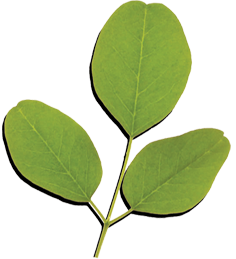RAISING PIGS ON MORINGA LEAVES
Originally appeared in: Amaranth to Zai Holes, Chapter 9.
Raising Pigs on Moringa Leaves is a system developed by missionary Paul Ronk in Jeremie, Haiti. Some people object to raising pigs because “pigs eat people food” and compete with humans. Paul tested and introduced a new feeding system based on moringa and leucaena leaves.
Every pig in Haiti was killed in 1981 because of the threat of an outbreak of the highly contagious African swine fever. Paul Ronk first went to Haiti to assist the U.S.-supported repopulation efforts which began in 1985. He found that the intensive production systems promoted along with the new pigs taken to Haiti were unsuitable for most Haitian farmers. Farmers were taught to use commercial hog feeds which were not too expensive initially but soon were priced far beyond the reach of small farmers. Paul witnessed many failures in the reintroduction projects due to the lack of adequate feed for the animals.
In 1991, the Ronk family moved to Jeremie in southwest Haiti. There were no pigs in the area when Paul arrived, so he decided to design and test a pig production system appropriate for the Haitian farmers. Before going to Haiti in 1987, he had spent several days at ECHO, and what he learned about trees with nutritious leaves led him to design a leaf-based feeding system which did not compete with humans for food. Four years later, the program has distributed 418 pigs. He estimates that now there are 5000 pigs in an 80-mile radius of Jeremie. Paul says that he must now address transport and marketing.
Regular food supply is critical to the health and successful raising of pigs. Farmers who wish to receive a pig are required to attend two weeks of training in which they learn the leaf-based feeding system, management of the trees, and basic veterinary care for their animal. They take home seeds of moringa (M. oleifera) and leucaena (L. leucocephala) for planting, and in six months an extensionist makes a field check on their farms to make sure the trees have become established. Paul reports that farmers have little trouble maintaining these species in his area. Farmers must have 100 trees each of both species before they receive their pig.
Farmers have a brief refresher course on veterinary care, then return home with a 12-week-old gilt (female pig) which weighs 30-40 pounds (13.6-18 kg). Monthly extension visits are made to each farm. Gilts reach 200 pounds (90.7 kg) in 12-14 months, at which time they are bred to selected boars. Piglets are born in 150 days; these pigs average 7 to a litter, while the world average is 8 and traditional Haitian pigs (before 1981) averaged only 3. The female pick of the litter is taken back to the mission at 8 weeks (about 20 lbs/9 kg), where it is nourished on commercial feeds for 3-4 weeks, until it is given to another farmer and the cycle begins again. Paul mentioned that the few weeks of commercial feed is not necessary, but is just a nutritional boost for the pig.
Moringa has many advantages in this system. Not only is it extremely nutritious and common in the area, it also withstands frequent severe prunings and can be cut short yet out of the reach of goats. Approximately 30 moringa trees, 10 leucaena trees, and a small quantity of other leaves such as banana and yam are needed to support each pig. The optimum diet in this system is about 70% moringa, 10% leucaena, and 20% other leaves. It is possible to feed pigs 100% moringa, but it is important that the diet not contain more than 30% leucaena, as the toxins have negative effects from infertility to death when given in high quantities. (Pigs with leucaena toxicity are identified by hair loss, a malnourished look, and inability to breed. If this happens, feed no more leucaena for 3 months and give high-protein feeds.)
Paul reports that the meat from these pigs is lean and tastes the same as pigs raised on other feeds. He describes the meat of sugarcane-fed hogs as fatty-watery. If sugarcane must be fed to the animals, it needs to be finely chopped–otherwise they expend more energy in chewing than they gain from calories. Dried leaves may make better feed, but Paul has found the drying process too laborious to justify the benefit in his situation. If you have questions for Paul Ronk, write him at Lynx Air International, P.O. Box 407139, Ft. Lauderdale, FL 33340, USA. ECHO will be EXTREMELY interested to learn of your results and/or innovations if you try this system.
moringa powder, moringa urban grow, climate change, moringa leaves powder, moringa medicine, moringa water purification., growing moringa, moringa stenopetala, buy moringa tea, moringa oil, moringa seeds, howto eat moringa, buy moringa products
